Journal of
eISSN: 2574-9943


Research Article Volume 5 Issue 3
1Department of plastic surgery, Faculdade Ciências Médicas de Minas Gerais, Brazil
2Anthropologist of Police Department of Minas Gerais State, Brazil
Correspondence: Luiz Eduardo Toledo Avelar, Faculdade Ciências Médicas de Minas Gerais, Brazil, Tel +55 31 3284-2141
Received: January 18, 2021 | Published: May 18, 2021
Citation: Avelar LET, Corradi LM. Mandible: evaluation of its morphology, aging process and sexual dimorphism for aesthetic treatment purpose. J Dermat Cosmetol. 2021;5(3):42-46. DOI: 10.15406/jdc.2021.05.00182
The mandible is the most important bone structure of the facial makeup. Its morphology differs with respect to genetic factors, sexual dimorphism, and age. Among its particular characteristics is the ability to adapt with its counterpart, the base of the skull, conferring a dynamic quality of this bone, by the mechanism of constant remodeling. In order to understand the involvement of the mandible in the evaluation of the lower third of the face, a fractional analysis of its parts is necessary considering morphological parameters of the mandibular angle. The purpose of this study is to demonstrate the importance of the mandible as an instrument in the analysis of the lower third of the face, allowing the accomplishment of aesthetic treatment, respecting the individual characteristics.
Keywords: anthropology, mandible morphology, aesthetic, face’s lower third, aging, sexual dimorphism
The mandible constitutes an important bone of the bony-facial structure, being the largest and the strongest of the face.1,2 It is extremely functional in the masticatory execution of food. Aesthetically, the mandible composes the lower third of the face, delimiting it inferiorly, interacting in its harmony. It is divided basically into two parts: the body and the ramus. The mandibular body has a “U” shape and has an outer and another inner surface, as well as a lower and an upper portion, where cavities, called alveolar processes, are found that support the teeth. Medially it displays a very important region, denominated mental region, with own characteristics.1 The ramus of the mandible is a quadrilateral bone blade that superiorly gives rise to two important prominences, the coronoid process and the mandibular condyle, being a region of insertion of important masticatory muscles such as the masseter and the temporal.1
Embryologically, the mandible has nuclei of its own ossifications that advance medially and that are united to the center.1 It presents a complex structural architecture and articulates with the base of the skull, in its posterior third. Its development, especially the mandibular ramus, has an important meaning to evidence craniofacial growth.3 That is, the mandibular branch leads the mandibular alveolar body and process in a changeable fit with the maxilla and structural variations of the face that occur both in the growth and in the maturation process of the face.3
In order to understand the involvement of the mandible in the evaluation of the lower third of the face, it is necessary to understand its entire development process. After this period, the process of transformation and adaptation, in according with its physiological functional demand, always codified by genetic inheritance, respond to the mechanism of bone remodeling conferring, thus, a dynamic quality to this structure.
With respect to its articulation with the base of the skull, the effect of the “counterpart”2 is applied, i.e., some regional anatomical features of the mandible, such as position and morphology of the ramus and body, accompany the base of the skull in its posterior third and produce effects of mandibular protrusion or retrusion, with consequent influence on the location of the mental region. Thus, the size and morphology of one part of the mandible is related to another,2 producing some structural effect, considering the typology of the face, sexual dimorphism, and the process of bone remodeling with advancing age.4
The objective of this study was to use the standards already applied in cases of forensic identification of anthropometric analysis regarding anatomical morphology, sexual dimorphism and aging, for evaluation and planning of patients for aesthetic treatment of facial harmonization.
The following analyses were performed in one patient for diagnosis and planning of harmonization of the lower third of the face:
The most significant questions on the mandible, worthy of discussion, either by its differentiation between both sexes, or by the constitutional and aging changes, are evaluated.
An interesting tool to understand the behavior of the mandible in the process of facial maturation is the analysis of the lower third of the face with the focus on the morphology of the mandibular angle and the mental region. The analysis of these structures aims to fractionate and evaluate how they interact and relate to each other for the orientation of how a therapeutic intervention can optimize facial harmony, without functional impairment.
Sexual dimorphism in the mandible can be assessed both qualitatively and quantitatively.5,12 One of the most notorious features that discerns the male mandible from the female is the vertical dimension. It is observed that the mandible of the man is much greater than that of the woman bringing a disproportion between the middle and lower thirds of the face. A man who is generally considered “handsome” usually has a certain pronouncement of the mandible. Therefore, every aesthetic professional needs to worry about and value this dimension in male patients.6
The most lateral points of the mandible, relative to the sagittal plane, are called gonions. Pronounced gonions are more common characteristics in men, although they are, sometimes, also marked in women.5 This factor contributes greatly to more square face acceptance in men. In general, male skulls have wider, stronger, heavier, and stronger mandibles, whereas female ones are more delicate. Another characteristic of differentiation are the rami of the mandible. These bone structures are stronger and more upright in man, while in women they are more delicate, less structured, concave 5,7 (Figure 1).
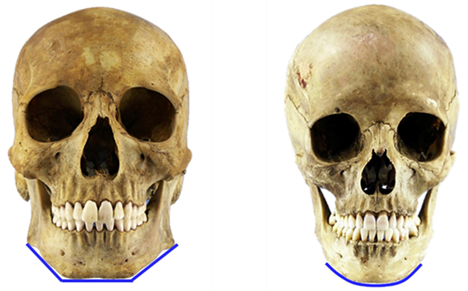
Figure 1 Differentiation between the male mandible. (A) stronger, heavier, quadrangular, and female, (B) more rounded and more delicate. Pronounced gonions are most commonly present in male mandibles and the rami, stronger and more rectified, contribute to the quadrangular aspect of the face.
Source: Forensic Anthropology Service of the Legal Medical Institute of Belo Horizonte.
On the other hand, the position of the mandible in relation to the sagittal plane (prognathism and retrognathism) is not defined as sexual dimorphism, since the extension of retrognathism is a characteristic of the shape of the head3. However, when a subnasal vertical line is extended, it is usually observed that the female face is located “behind” that line, that is, the forehead rarely coincides with the line which, in turn, is equidistant along the nasal slope. In the male pattern, on the contrary, both the forehead and the nose are usually protrusive enough to approach that subnasal vertical line, sometimes overtaking it. Thus, a certain degree of mandibular prognathism is acceptable in a male, and the same degree of prognathism in a woman should be re-evaluated3,5 (Figure 2). Mental region is one of the areas of the mandible that presents the most variable morphology, in the different types and basic facial patterns3. It also shows a lot of sexual differentiation. Normally, following the rest of the cranial characteristics, the masculine mental region is angled and lateral pronounced, making it more squared. The female, like all the rest of the facial skeleton, is rounded, less pronounced7 (Figure 3).
An important characteristic observed with aging is the loss of the vertical dimension of both the maxilla and the mandible, providing a decrease of all height.5,8,9 In addition, with age, tooth wear resulting from masticatory function occurs. The resultant vector of this wear is normally anterior, that is, as one ages, a small anterior projection of the entire mandibular complex occurs due to the decrease in the value of its vertical dimension determined, in part, by dental wear, and, consequently, remodeling of the mandibular angle, projecting forward.5,10 In this way, both vertical decrease and greater anterior projection of the mandible are observed, manifesting through an oblique positioning of the chin5,6,8,10 (Figure 4). All this process occurs simultaneously and discreetly, but gives an “aged” (unpleasant) aspect of the lower third of the face, leading all of its structures, including muscles, to adapt to this “new” profile of the lower third of the face.

Figure 4 In A, aspect of the mandibular morphology of a young individual (more closed angle and more rectilinear delineation); in B, mandibular morphology of an older individual (more open mandibular angle, anterior projection of the mental region and smaller vertical dimension).
The total absence of dental elements induces an even greater bone resorption. There is, in these cases, a loss of the alveolar processes and, later, even of the mandibular bone itself due to absence of the antagonistic tooth. Younger people, therefore, have a more structured mandible that, over time, becomes less pronounced and with less bone volume. This process of aging is very evidenced by checking position of the mentonian foramina. In young patients it is between the upper and lower limits of the mandible, but with the aging process, it becomes more upward and close to the mandibular upper border. In dental edentulous patients, their presence is so specific that it is difficult to place dental prostheses because they are located more superficially and very close to the upper margin5 (Figure 5).
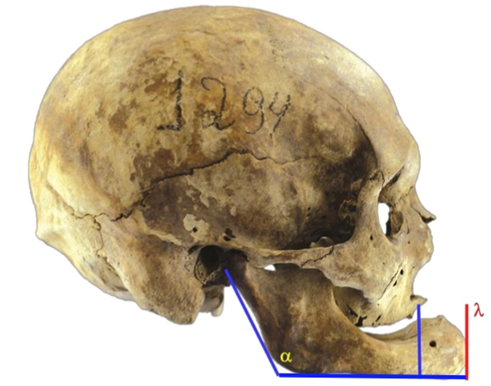
Figure 5 Aspect of mandibular morphology of an older individual with total loss of teeth: more open mandibular angle (a), anteriority of the chin (l), diminution of vertical dimension and higher position of the mentonian foramen.
The size and morphology of the lower third of the face change with age in both men and women, with no predominance between the sexes. The lower margin of the mandible body becomes flattened, losing its curvature4 (Figure 6).

Figure 6 In A, individual with age around 18 years old; B, around 40 years; C, around 60 years of age: there is observed diminution of the vertical dimension with the advancing age.
All the muscular tissues of the face, during the life time, follow their structural bases, since functionally active.2
Some small features of mandibular morphology can have a major impact on the face of the individual,3 in particular in its lower third. In terms of variation in shape, size, age, and sex, based on Bjork’s evaluation studies, the cephalometric analysis of Jarabak2 proposes a fractional criteria of the analysis of the craniofacial complex considering jaw relations between them in the anteroposterior and the vertical directions. From these relationships, the analysis of the mandibular angle, with reflex in the position and location of the mental region, becomes an important point to be considered.
Thus, the regions of the face that deserve special attention for the vital importance of mandibular aging, which are fundamental for facial aesthetics, are the mandibular angle and the mental region.
The mandibular angle, or gonial angle, is formed by the union of tangents to the lower edge jaw body and posterior edge of the ascending ramus.2,5
In some cephalometric analyses, such as Roth-Jarabak,2 measures of the gonial angle is considered as an important mechanism to check, or prediction, of how the lower facial height will behave after the period of growth of the face. That is, the mandibular angle is one of the most important factors in the result of the involvement of the lower third of the face, in relation to the aesthetics of the whole facial structure, exerting a strong influence on its appearance.
However, for assessment of the gonial angle, some pondering should be given to the position between the ramus and the body of the mandible, not only its total value,3 respecting its regional anatomical characteristics, besides the relation of the mandibular ramus to the posterior base of the cranium.3 Thus, the mandible ramus may be more vertical, with the mandibular angle being more open (Figure 7B). Rather, an inclination of this margin can make the angle between the ramus and jaw bodymore closed, being a more prognathous face2 (Figure 7A).
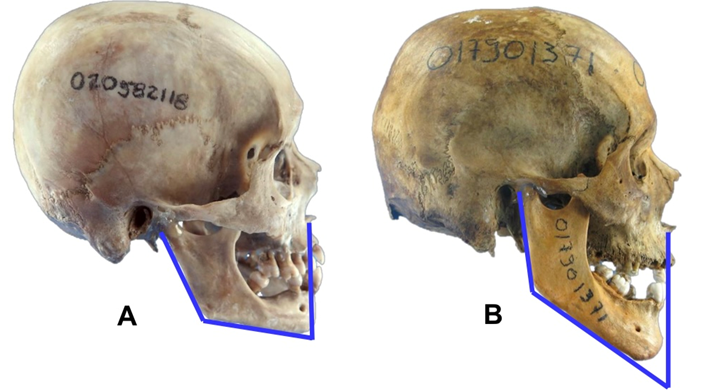
Figure 7 In A, most inclined ramus of the mandible, the angle between the ramus and body of the mandible more open, being a more prognathic face; in B, ramus of the mandible is more vertical, the measurement of the mandibular angle more open, the face being more retrognathic.
This can be explained by the constant and dynamic mechanism of bone remodeling of the mandible that happens mainly in its ramus, exerting, therefore, great influence on the morphology and position of jaw body and mental region.3
As previously discussed, the value of the mandibular angle defines the morphology of the mandible and its relation to the height of the face. In terms of values, below 123º the jaw is usually square and the face height is short. Above 130º, the height of that of the lower third is more elongated.2 However, its value should not be evaluated only as a single factor of morphology and relation to face height. The way in which the ascending ramus and the body are related to each other to form the gonial angle will demonstrate how its growth,2 as well as its “aging” process, managed by the dynamics of bone remodeling, will influence the facial structures, especially in their lower third.
Facial development does not occur alone. It is conditioned to its counterpart, the base of the skull3, in addition to structural patterns and genetic factors.2,3 Recent studies11 confirmed that there are constant changes with age in both the skull cap, its exo- and endocranial faces, and its base, being specific for each sex.
Thus, the geometric form of the face as a whole will be the same during the development of the individual. In the same way, the mandible can assume different positions with the craniofacial mass maintaining its morphology, without changing its total form.3 What can change for each individual is the proportion that exists in each regional part of the mandible, according to facial pattern, age and sexual dimorphism.
Using fractional criteria to analyzethe component parts of the craniofacial complex, as recommended by the cephalometric analysis of Roth-Jarabak,2 it is proposed to divide the mandibular angle into two compartments (the upper and the lower) by drawing an imaginary line between the point nasium and gonion (Na-Go). For this, as a benchmark of face posture, the Frankfurt plane is used parallel to the ground, and to sagittally dimension the location of the mental region, that is, if retracted or protruded, a subnasal vertical line is drawn. (Figure 8).

Figure 8 Traces of the analysis of the lower third of the face: a = upper gonial angle; b = lower gonial angle; l = vertical subnasal line; t = Frankfurt plane.
The upper angle describes an oblique position of the ascending ramus and indicates how the mandible behaves sagittally. In terms of values, according to Jarabak, the norm of the superior gonial angle is 52 to 55 degrees.2 When this value is increased in relation to the norm, it indicates that the mandible will have a more horizontal positioning determining a more prognathic facial type, with diminished value of lower third of the face (Figure 9 A). In turn, its decreased value with respect to the norm shows a more vertical mandibular positioning, with little anterior projection of the chin and, consequently, an increased value of the lower third of the face (Figure 9B).
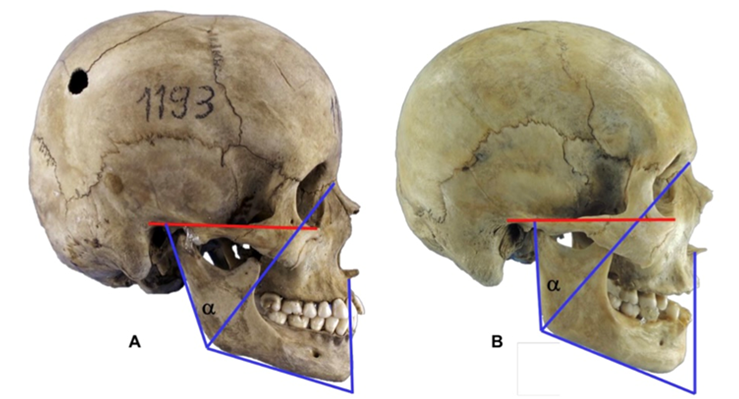
Figure 9 A - superior gonial angle (a ) measured 57º (higher than norm); B - superior gonial angle (a ) measured 45º (lower than norm).
The lower gonial angle describes the inclination of the jaw body and determines the positioning of the chin in its vertical direction. Its norm is 70 to 75 degrees.2 An increased value indicates a larger inclination of the mandibular body downwards, more upright positioning of the chin with consequent increase of the lower facial height (Figure 10A). Its diminished value confers a more horizontal mandibular body associated with a more anterior projection of the mental region and decrease of the vertical dimension (Figure 10B).
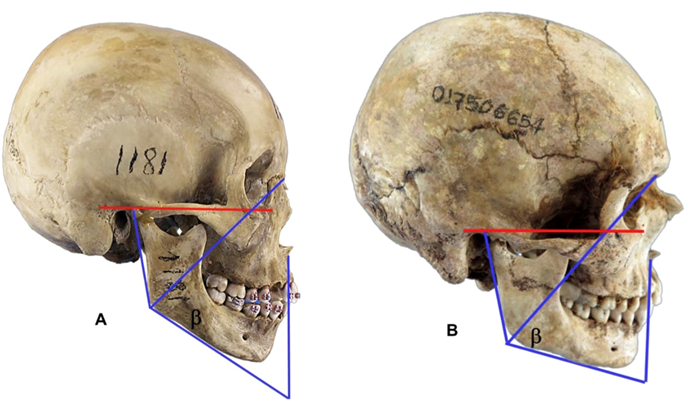
Figure 10 A - lower gonial angle (b) measured 77º (higher than norm); B lower gonial angle (b) measured 66º (lower than norm).
Thus, it is noted that the morphology of the gonial angle is not modified only by facial aging, but it is also determined by the genetic code of the craniofacial profile, by the sexual dimorphism and by the relation of dental occlusion, influencing in an expressive way the behavior of the lower third of the face.
Based on these methodological principles of analysis of the lower third of the face, its application in clinical practice is exemplified. For this, the gonial angle measurement was fractioned and showed total value increased (135º), the upper one diminished (45º) and the lower one increased (90º) Values proposed by Roth-Jarabak2 cephalometry were used as described above (Figure 11).
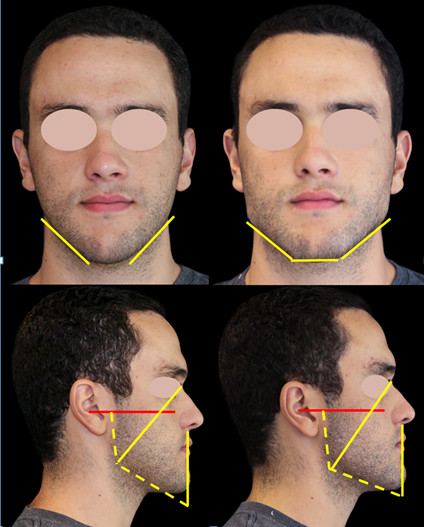
Figure 11 The values of the diminished upper gonial angle (45º) and the increased inferior gonial angle (90º) are noted. After aesthetic procedure, in frontal norm, a significant improvement of the mandible contour is observed; in lateral norm, notice a change of the mandibular angle from 135º to 110º, with improvement of the contour of the inferior margin of the mandibular body.
However, the position of the mental region near the vertical subnasal line is due to its common structural morphology in males, i.e., more pronounced. There is a disproportion between the thirds of the face, in the sagittal direction, with an evident increased value of the lower third (Figure 11). This facial typology, in aesthetic terms, is acceptable in males.
As determined in the facial evaluation of this specific patient, his mandibular angle was beyond what was desired, mainly due to a greater projection of his inferior gonial angle, which gave him an unpleasant aesthetic aspect. In order to provide greater facial harmony, it became imperative to decrease the overall value gonial angle, especially its lower angle. In this way, a vertical advancement of the gonions and mandibular body was chosen, with the use of a higher G-prime hyaluronic acid to decrease the oblique axis of the face and its lower angle. The result showed a greater harmony of the lower third of the face and a change of the mandibular angle from 135º to 110º, with significant improvement of the mandibular contour in both frontal and lateral views (Figure 11).
The correct diagnosis, based on the analysis of the facial profile in its lower third, considering morphological parameters of the mandibular angle and the chin, with their differentiations in both sexes and with the increase of the age, allows the accomplishment of ideal aesthetic treatment customized for each patient, always respecting their individual characteristics.
None.
The authors have no conflict of interest to declare.
None.

©2021 Avelar, et al. This is an open access article distributed under the terms of the, which permits unrestricted use, distribution, and build upon your work non-commercially.